There have a few notes on this site about the tactile guideways for the blind found in most Chinese cities. In theory, they are a great idea that make it easier for the blind and vision impaired to get around the city. This post will briefly introduce the guideways we see on every street, illustrate the design and enforcement shortfalls, and consider potential improvements.
You may be familiar with tactile tiles like this one above, many (but certainly not all!) curb ramps in the United States have these pads to warn those with vision impairments of road crossings. There line train platforms and often serve as a warning strip. In China, the entire sidewalk in most cities have been rebuilt with “blind paths/lanes/ tracks” that consist of textured tiles that ideally will guide people around hazards. In 2001, the central government required identified paths to be built along all major roads. In 2008, the legislature required all new buildings to be built with barrier-free features. Progress is being made and is manifested in the thing yellow lines that run along most every sidewalk.
Tactile guideways..
…Or, braille tiles, textured tiles, etc. Tactile guideways help those with vision impairments find their way safely through city streets. They should offer contrasting tactile information when a user reaches a crossing, should be logically laid out to aid orientation and improve user safety.The below video illustrates how those with vision impairments are aided by tactile guideways:
User of tactile guideway
Unfortunately, most streets in Beijing, and I suspect elsewhere in China, offer blocked guideways, difficult angles to navigate and abundant navigational challenges. Chinese human rights blogger Yu Jianrong made a call to arms for Weibo (Chinese twitter) users to document the “most hideous” blind lanes. Hundreds of photos were submitted, below are a few of the submissions before the “contest” was terminated:
One day this week I took some pictures along a few block (the blocks are quite huge…) walk near downtown Beijing. This is the variety of scenes I noticed along the “blind lane,” from clear sailing and helpful guidance around obstacles to selfish parking habits and tree-line gauntlet:
It is easy to be critical of the sometimes humorous layout and potential dangers presented by the guideways as they are currently configured, but most often they do provide improved wayfinding for those that most need it. Indeed, this wayfinding aid is more than most Western cities offer.
The Chinese government has identified the need for further “barrier-free” improvements to be made in most cities. Throughout China huge strides are being made to develop more accessible places and transportation systems, especially for the old, young, and those with mobility limitations. These efforts toward the creation of “barrier-free cities” will benefit all pedestrians when planning and design shifts toward people instead of cars. Just like home!
Already, thousands of kilometers of tactile pathways have been laid, ramps (of varying quality and steepness) have been made, hand rails installed, and public transportation made more accessible. One count states that Beijing has over 1,500 km of tactile pathways on more than 800 sidewalks. Dalian, a city of about 4 million residents, was first named the National Demonstration City and later the National Barrier-free City by the central government. Through access ramps, accessible homes employing universal design, and education throughout the city, Dalian has become the national example of how to improve access and mobility for those with physical limitations. Chinese cities are making big strides ahead in accessibility and it seems like public awareness is increasing as well. This is great news for the estimated 80+ million Chinese with mobility limitations.
The main issues that I have noted in Beijing are people blocking the way with cars, sometimes egregiously:
In time, I am convinced that more of these violators will be ticketed, banned, publicly shamed, towed, or dealt with how the Vilnius mayor takes care of the situation. Also, yes, that is a Maserati Quattroporto…
Another issue with the tiles is that they are built into the sidewalk. The current designs rely on right angles and make for slow and difficult navigation. Ideally, these would be ground into the sidewalk after or built in smoother lines that would more safely guide the visually impaired around obstacles. One issue may be the corporate interests that produce the tiles, I would think that they have guaranteed business through the current design.
Currently, road crossings remain quite dangerous (for all users). For those with visual impairments, there is not any clear means of crossing chaotic intersections. Audible cross tones would do little if all other users ignore protocols.
Overall, it seems like Chinese cities are making big efforts toward accessibility. It is a process that will take time, but my hope is for safer, more accessible cities for all people in the years to come. With future improvements to signalized crossings, and enforcement of sidewalk parking infractions, the “blind lanes” may become immensely more useful for those who are visually impaired.

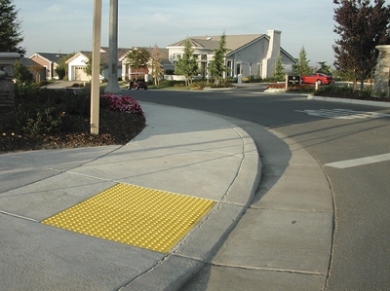



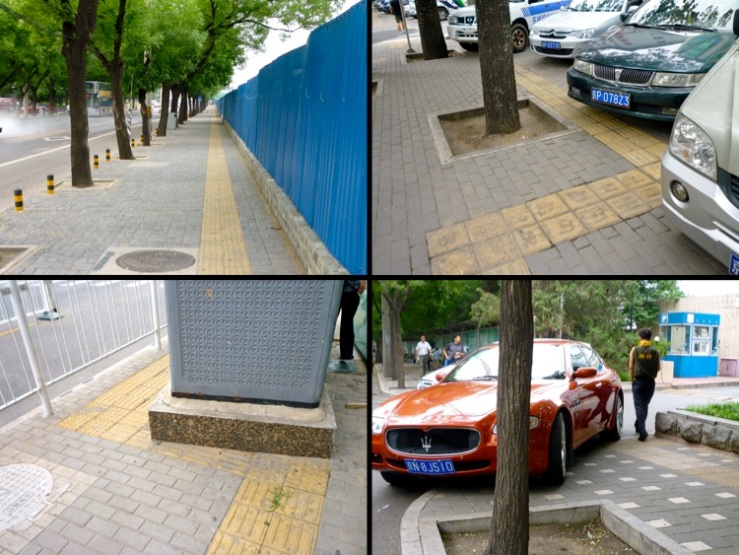
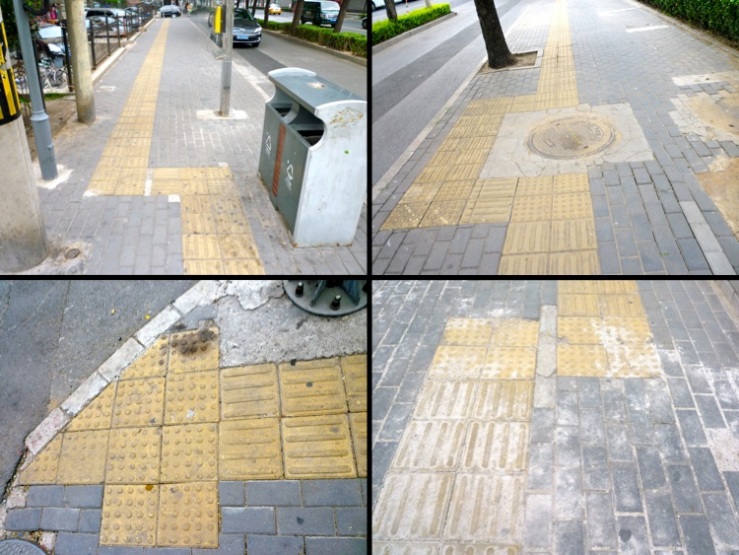
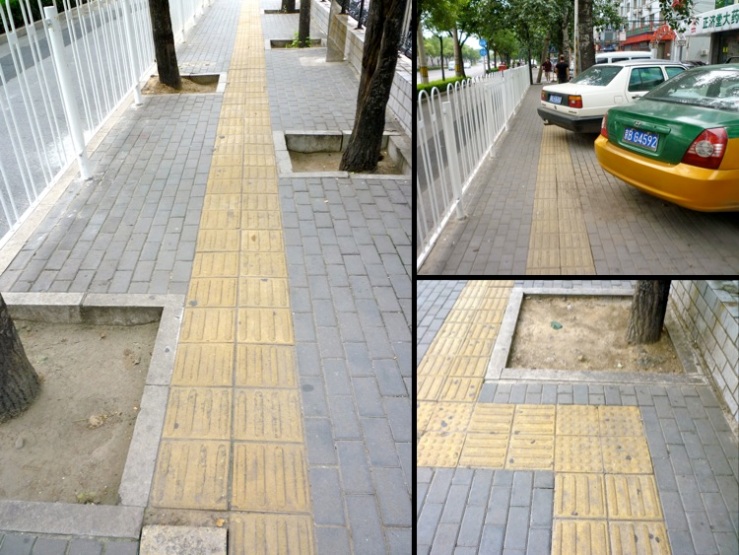
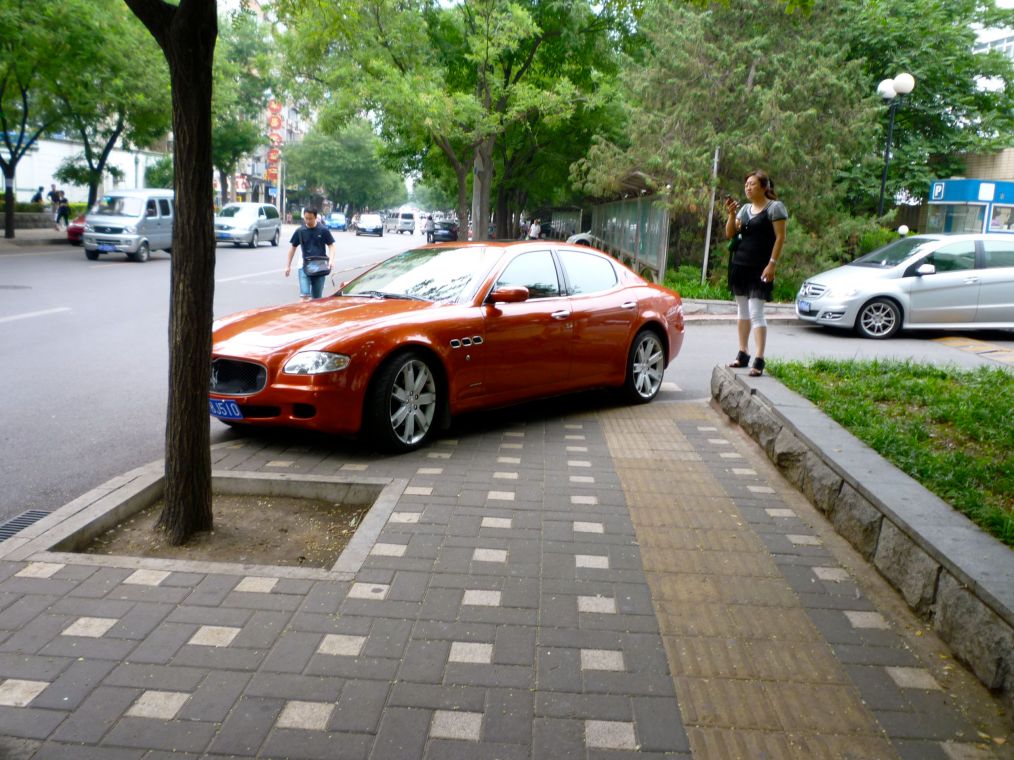
Brilliant post! I have to admit to laughing out loud at the submissions from Weibo even though it’s really quite a serious thing. I think Jenny commented on this before, but we have not seen a single blind person here. Part of me wonders about what they would look like navigating these streets.
It seems to me that these raised tiles would make using a cane next to impossible (it would get caught on the bumps), so maybe they’re not using canes and are therefore less obvious. Although, now that I think about it, I don’t hear any warning noises that it is safe to walk when the green walk light comes on, let alone the obvious problem that even for us younger sighted able-bodied folks, it is next to impossible to get all the way across the street on a walk light without running.
We have not seen people in wheelchairs either, and again, I’m not sure how they would be served by the sidewalks. The bump strips here often slope down to the street level, but in narrow troughs that would seem to bar travel of wheelchairs.
Have you seen anyone actually using these?
LikeLike
Never seen a blind person make use of the ‘bumps’. Seen a wheel-chair in use ….pushed down the road – not the sidewalk. While the idea is good, the implementation is extremely poor.
And don’t forget – those raised bumps are hell to walk on!!!
LikeLike
Here’s a video I failed to properly imbed of a blind user of the tactile guideways. Seems to work well.
Note that the guideway in the video arc and follow natural walking paths around obstacles. Go to about 1:30…
LikeLike
[…] cardboard in the middle of the street. The yellow is the “blind path” on most streets sourceI have no idea why this is, but perhaps its because of the lack of access to health care early on to […]
LikeLike
[…] CASS scholar Yu Jianrong appealed last year for weibo users to post photos of China’s “most hideous” Braille paving. Colin Rowan collected some of the results at Transplanet. […]
LikeLike
[…] Circuitous tactile paving routes in China by Colin Rowan […]
LikeLike
[…] Transplanet Blog […]
LikeLike
[…] C 2012, ‘A “blind lane” in Beijing’, photograph, wordpress, viewed on 23 June 2019, <https://psuchina.wordpress.com/2012/07/27/blind-lanes-in-china/>. Fig.10. Ho, H 2019, ‘Tactile blocks indicate steps in RMIT University, Vietnam’, […]
LikeLike